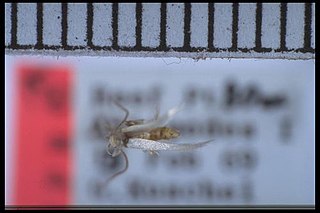
The Elachistidae are a family of small moths in the superfamily Gelechioidea. Some authors lump about 3,300 species in eight subfamilies here, but this arrangement almost certainly results in a massively paraphyletic and completely unnatural assemblage, united merely by symplesiomorphies retained from the first gelechioid moths.

Gelechioidea is the superfamily of moths that contains the case-bearers, twirler moths, and relatives, also simply called curved-horn moths or gelechioid moths. It is a large and poorly understood '"micromoth" superfamily, constituting one of the basal lineages of the Ditrysia.

The Batrachedridae are a small family of tiny moths. These are small, slender moths which rest with their wings wrapped tightly around their bodies.

Pterolonchidae is a small family of very small moths in the superfamily Gelechioidea. There are species native to every continent except Australia and Antarctica.

Elachista is a genus of gelechioid moths described by Georg Friedrich Treitschke in 1833. It is the type genus of the grass-miner moth family (Elachistidae). This family is sometimes circumscribed very loosely, including for example the Agonoxenidae and Ethmiidae which seem to be quite distinct among the Gelechioidea, as well as other lineages which are widely held to be closer to Oecophora than to Elachista and are thus placed in the concealer moth family Oecophoridae here.

Stephensia is a genus of the small and very small moths of the family Elachistidae.

Urodeta is a genus of moths of the family Elachistidae. The genus was originally assigned to the family Momphidae.
Perittia serica is a moth of the family Elachistidae. It is found in Colorado.
Coelopoeta is a relatively divergent genus of small moths in the superfamily Gelechioidea, which have only been found in western North America.
Elachista simplimorphella is a moth in the family Elachistidae. It was described by Sinev and Sruoga in 1995. It is found in south-eastern Siberia.
Elachista tersella is a moth in the family Elachistidae. It was described by Sinev and Sruoga in 1995. It is found in south-eastern Siberia.
Elachista sinevi is a moth in the family Elachistidae. It was described by Sruoga in 1992. It is found in Kazakhstan.
Elachista vakshi is a moth in the family Elachistidae. It was described by Sruoga in 1992. It is found in Central Asia.

Elachista antipodensis is a moth in the family Elachistidae. It was first described by John S. Dugdale in 1971. It is found on the Antipodes Islands.
Urodeta acinacella is a moth of the family Elachistidae first described by Jurate De Prins and Virginijus Sruoga in 2012. It is found in South Africa, where it has been recorded from the Tswaing Crater Reserve in Gauteng.
Perittia punatensis is a moth in the family Elachistidae. It was described by Lauri Kaila in 2000. It is found in Bolivia.
Perittia smaragdophanes is a moth in the family Elachistidae. It was described by Edward Meyrick in 1932. It is found in Ecuador.
Perittia spermatopis is a moth in the family Elachistidae. It was described by Edward Meyrick in 1933. It is found in Argentina.
Epimarptidae was a former, or is a possible, monotypic family of moths in the moth superfamily Gelechioidea. It can now be seen as either a synonym of family Batrachedridae, or a monotypic subfamily of that family.






